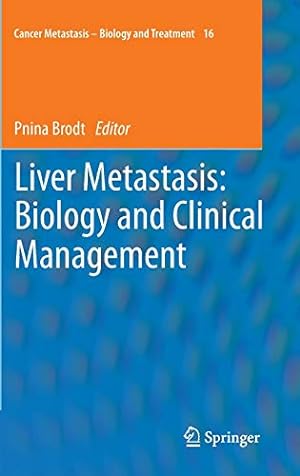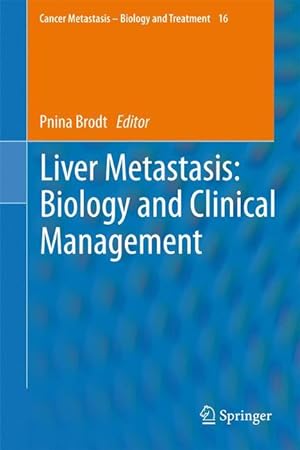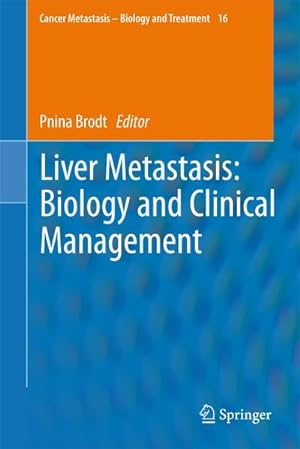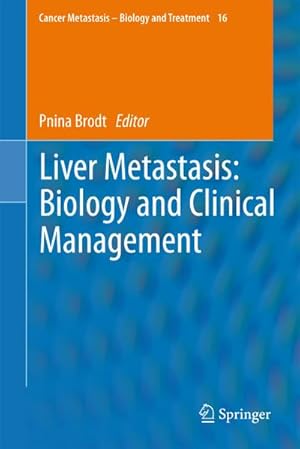9789400702912 - Liver Metastasis: Biology and Clinical Management: 16 Cancer Metastasis - Biology and Treatment, 16 (13 results)
FeedbackSearch filters
Product Type
- All Product Types
- Books (13)
- Magazines & Periodicals (No further results match this refinement)
- Comics (No further results match this refinement)
- Sheet Music (No further results match this refinement)
- Art, Prints & Posters (No further results match this refinement)
- Photographs (No further results match this refinement)
- Maps (No further results match this refinement)
- Manuscripts & Paper Collectibles (No further results match this refinement)
Condition Learn more
- New (11)
- As New, Fine or Near Fine (1)
- Very Good or Good (1)
- Fair or Poor (No further results match this refinement)
- As Described (No further results match this refinement)
Binding
- All Bindings
- Hardcover (13)
- Softcover (No further results match this refinement)
Collectible Attributes
- First Edition (No further results match this refinement)
- Signed (No further results match this refinement)
- Dust Jacket (No further results match this refinement)
- Seller-Supplied Images (5)
- Not Print on Demand (10)
Language (1)
Free Shipping
Seller Location
Seller Rating
-
Liver Metastasis: Biology and Clinical Management (Cancer Metastasis - Biology and Treatment, 16)
Seller: Redux Books, Grand Rapids, MI, U.S.A.
Hardcover. Condition: Very Good. AN UNUSED COPY but with shelving/packing damage.Front hinge is starting to crack; 100% Satisfaction Guaranteed! Ships same or next business day!
-
Liver Metastasis: Biology and Clinical Management (Cancer Metastasis - Biology and Treatment, 16)
Seller: Best Price, Torrance, CA, U.S.A.
Condition: New. SUPER FAST SHIPPING.
-
Liver Metastasis: Biology and Clinical Management (Cancer Metastasis - Biology and Treatment, 16)
Seller: Lucky's Textbooks, Dallas, TX, U.S.A.
Condition: New.
-
Liver Metastasis: Biology and Clinical Management
Published by Springer Netherlands, 2011
ISBN 10: 9400702914 ISBN 13: 9789400702912
Language: English
Seller: moluna, Greven, Germany
£ 160.92
Convert currency£ 42.51 shipping from Germany to U.S.A.Quantity: Over 20 available
Add to basketGebunden. Condition: New.
-
Liver Metastasis: Biology and Clinical Management (Cancer Metastasis - Biology and Treatment, 16)
Seller: Ria Christie Collections, Uxbridge, United Kingdom
£ 191.22
Convert currency£ 11.98 shipping from United Kingdom to U.S.A.Quantity: Over 20 available
Add to basketCondition: New. In.
-
Liver Metastasis: Biology and Clinical Management
Published by Springer Netherlands, Springer Netherlands Mär 2011, 2011
ISBN 10: 9400702914 ISBN 13: 9789400702912
Language: English
Seller: buchversandmimpf2000, Emtmannsberg, BAYE, Germany
£ 191.24
Convert currency£ 52.06 shipping from Germany to U.S.A.Quantity: 2 available
Add to basketBuch. Condition: Neu. Neuware -Liver metastases are a frequent and often fatal occurrence in cancer patients, particularly those with malignancies of the gastrointestinal (GI) tract. While recent improvements in surgical techniques and a more aggressive approach to resection of liver metastases have improved long term survival for some patients, most patients with hepatic metastases still succumb to their disease. To improve these dismal statistics, a better understanding of the biology of liver metastasis, particularly the early stages that can be targeted for prevention, is essential.Once cancer cells enter the liver, several different scenarios may occur. The cancer cells may be immediately destroyed by local defence mechanisms, they may enter a state of dormancy as solitary cells and never produce a metastasis, initiate a short-lived process of proliferation that is aborted before a metastasis is established or actively proliferate to form macrometastases. The chapters in Part I of this book provide insight into the cellular/molecular mechanisms that determine which of these scenarios prevails. Written by experts researchers in the filed of metastasis, these chapters provide state-of-the art reviews on the cellular and molecular processes that impact the early stages of the metastatic process. The unique microenvironment of the liver, its various anatomical, cellular and molecular features and the impact they have on metastasis are highlighted. In addition, the role of inflammation (pre-existing and tumor-induced), host innate and adaptive immune responses, cytokines, chemokines, growth factors and the unique molecular signatures of metastatic tumor cells are reviewed with an underscoring of thetranslational implications of the current state of knowledge.Against this background, the chapters in Part II of the book provide critical reviews on major aspects of the clinical management of hepatic metastases. These include imaging strategies, surgical and chemotherapeutic treatment approaches and the use of targeted biological therapeutics such as anti-angiogenic drugs as treatment modalities.By combining information on biological and clinical aspects of liver metastasis, this volume will serve as an excellent resource for scientists, clinicians, clinician/ scientists and trainees in the domains of oncology, surgical oncology, hepatobiliary physiology and radiology.Springer Verlag GmbH, Tiergartenstr. 17, 69121 Heidelberg 460 pp. Englisch.
-
Condition: New. pp. 462.
-
Liver Metastasis: Biology and Clinical Management
Published by Springer Netherlands, Springer Netherlands, 2011
ISBN 10: 9400702914 ISBN 13: 9789400702912
Language: English
Seller: AHA-BUCH GmbH, Einbeck, Germany
£ 194.33
Convert currency£ 55.75 shipping from Germany to U.S.A.Quantity: 1 available
Add to basketBuch. Condition: Neu. Druck auf Anfrage Neuware - Printed after ordering - Liver metastases are a frequent and often fatal occurrence in cancer patients, particularly those with malignancies of the gastrointestinal (GI) tract. While recent improvements in surgical techniques and a more aggressive approach to resection of liver metastases have improved long term survival for some patients, most patients with hepatic metastases still succumb to their disease. To improve these dismal statistics, a better understanding of the biology of liver metastasis, particularly the early stages that can be targeted for prevention, is essential. Once cancer cells enter the liver, several different scenarios may occur. The cancer cells may be immediately destroyed by local defence mechanisms, they may enter a state of dormancy as solitary cells and never produce a metastasis, initiate a short-lived process of proliferation that is aborted before a metastasis is established or actively proliferate to form macrometastases. The chapters in Part I of this book provide insight into the cellular/molecular mechanisms that determine which of these scenarios prevails. Written by experts researchers in the filed of metastasis, these chapters provide state-of-the art reviews on the cellular and molecular processes that impact the early stages of the metastatic process. The unique microenvironment of the liver, its various anatomical, cellular and molecular features and the impact they have on metastasis are highlighted. In addition, the role of inflammation (pre-existing and tumor-induced), host innate and adaptive immune responses, cytokines, chemokines, growth factors and the unique molecular signatures of metastatic tumor cells are reviewed with an underscoring of thetranslational implications of the current state of knowledge. Against this background, the chapters in Part II of the book provide critical reviews on major aspects of the clinical management of hepatic metastases. These include imaging strategies, surgical and chemotherapeutic treatment approaches and the use of targeted biological therapeutics such as anti-angiogenic drugs as treatment modalities. By combining information on biological and clinical aspects of liver metastasis, this volume will serve as an excellent resource for scientists, clinicians, clinician/ scientists and trainees in the domains of oncology, surgical oncology, hepatobiliary physiology and radiology.
-
£ 255.06
Convert currency£ 25 shipping from United Kingdom to U.S.A.Quantity: 2 available
Add to basketHardcover. Condition: Brand New. 1st edition. 446 pages. 9.25x6.25x1.25 inches. In Stock.
-
Liver Metastasis: Biology and Clinical Management (Cancer Metastasis - Biology and Treatment)
Seller: Mispah books, Redhill, SURRE, United Kingdom
£ 282
Convert currency£ 25 shipping from United Kingdom to U.S.A.Quantity: 1 available
Add to basketHardcover. Condition: Like New. Like New. book.
-
Liver Metastasis:Biology and Clinical (eng)
Seller: Brook Bookstore On Demand, Napoli, NA, Italy
£ 148.61
Convert currency£ 6.94 shipping from Italy to U.S.A.Quantity: Over 20 available
Add to basketCondition: new. Questo è un articolo print on demand.
-
Liver Metastasis: Biology and Clinical Management
Published by Springer Netherlands, Springer Netherlands Mär 2011, 2011
ISBN 10: 9400702914 ISBN 13: 9789400702912
Language: English
Seller: BuchWeltWeit Ludwig Meier e.K., Bergisch Gladbach, Germany
£ 191.24
Convert currency£ 19.96 shipping from Germany to U.S.A.Quantity: 2 available
Add to basketBuch. Condition: Neu. This item is printed on demand - it takes 3-4 days longer - Neuware -Liver metastases are a frequent and often fatal occurrence in cancer patients, particularly those with malignancies of the gastrointestinal (GI) tract. While recent improvements in surgical techniques and a more aggressive approach to resection of liver metastases have improved long term survival for some patients, most patients with hepatic metastases still succumb to their disease. To improve these dismal statistics, a better understanding of the biology of liver metastasis, particularly the early stages that can be targeted for prevention, is essential. Once cancer cells enter the liver, several different scenarios may occur. The cancer cells may be immediately destroyed by local defence mechanisms, they may enter a state of dormancy as solitary cells and never produce a metastasis, initiate a short-lived process of proliferation that is aborted before a metastasis is established or actively proliferate to form macrometastases. The chapters in Part I of this book provide insight into the cellular/molecular mechanisms that determine which of these scenarios prevails. Written by experts researchers in the filed of metastasis, these chapters provide state-of-the art reviews on the cellular and molecular processes that impact the early stages of the metastatic process. The unique microenvironment of the liver, its various anatomical, cellular and molecular features and the impact they have on metastasis are highlighted. In addition, the role of inflammation (pre-existing and tumor-induced), host innate and adaptive immune responses, cytokines, chemokines, growth factors and the unique molecular signatures of metastatic tumor cells are reviewed with an underscoring of thetranslational implications of the current state of knowledge. Against this background, the chapters in Part II of the book provide critical reviews on major aspects of the clinical management of hepatic metastases. These include imaging strategies, surgical and chemotherapeutic treatment approaches and the use of targeted biological therapeutics such as anti-angiogenic drugs as treatment modalities. By combining information on biological and clinical aspects of liver metastasis, this volume will serve as an excellent resource for scientists, clinicians, clinician/ scientists and trainees in the domains of oncology, surgical oncology, hepatobiliary physiology and radiology. 460 pp. Englisch.
-
Liver Metastasis
Seller: Majestic Books, Hounslow, United Kingdom
£ 259.15
Convert currency£ 6.50 shipping from United Kingdom to U.S.A.Quantity: 4 available
Add to basketCondition: New. Print on Demand pp. 462 Illus.







